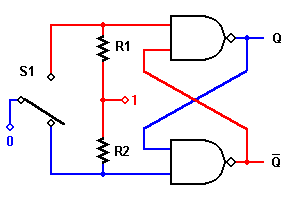Combinational Logic:
[Basic Gates]
[Derived Gates]
[The XOR Function]
[Binary Addition]
[Multiplexer]
[Decoder/Demultiplexer]
Sequential Logic:
[RS NAND Latch]
[Clocked RS Latch]
[RS Flip-Flop]
[JK Flip-Flop]
[D Latch]
[Flip-Flop Symbols]
Counters:
[Basic 4-Bit Counter]
Registers:
(Coming Soon)
Return to Digital index page.
Return to Play-Hookey Home Page.
In order for a logical circuit to "remember" and retain its logical state even after the controlling input signal(s) have been removed, it is necessary for the circuit to include some form of feedback. We might start with a pair of inverters, each having its input connected to the other's output. The two outputs will always have opposite logic levels.
The problem with this is that we don't have any additional inputs that we can use to change the logic states if we want. We can solve this problem by replacing the inverters with NAND or NOR gates, and using the extra input lines to control the circuit.
The circuit shown below is a basic NAND latch. The inputs are generally designated "S" and "R" for "Set" and "Reset" respectively. Because the NAND inputs must normally be logic 1 to avoid affecting the latching action, the inputs are considered to be inverted in this circuit.
The outputs of any single-bit latch or memory are traditionally designated Q and Q'. In a commercial latch circuit, either or both of these may be available for use by other circuits. In any case, the circuit itself is:

This circuit has quite a number of limitations, and can be improved in many ways as you'll see shortly. However, it does have a very practical application almost without changes. Any mechanical switch experiences a phenomenon called "contact bounce." Whenever you press the button or change the switch position, the physical contacts will flex a little, causing them to make and break several times before settling down. You don't notice this when turning on a light in your home, but digital circuits are fast enough that they do notice this behavior and transmit it faithfully. If you are trying to test a new digital circuit by sending it one clock pulse at a time, this will cause all sorts of headaches.
The solution is to use an SPDT (Single-Pole, Double-Throw) pushbutton or switch, as shown in the figure to the right. Normally, the switch is of the break-before-make type, so there will be some part of the switch motion when all three contacts are disconnected from each other. Now, the unconnected input is held at a logic 1 through its resistor (an electronic component that allows an electrical connection without causing a dead short), while the connected input is held at logic 0 by the direct connection through the switch.
When the switch is moved to the other setting or the button is pressed, the very first contact will cause the latch to change state, but additional bounces will have no further effect. This eliminates the contact bounce and sends a single, clean digital transition to the next circuit. All of the interactive digital demonstrations behave in a debounced fashion, and would use this type of circuit if constructed physically.
One problem with the basic RS NAND latch is that the input levels need to be inverted, sitting idle at logic 1, in order for the circuit to work. It would be helpful, as well as more intuitive, if we had normal inputs which would idle at logic 0, and go to logic 1 only to control the latch. This much we can do simply by placing inverters at the inputs.
However, there is another problem we need to address: How to control when the latch is allowed to change state, and when it is not. This is necessary if we have a group of latches and want to be sure they all change state (or not) at the same time. We'll see how both of these concerns can be easily addressed on the next page.
|
|
|
|
| Return to Digital Page | The Clocked RS Latch |